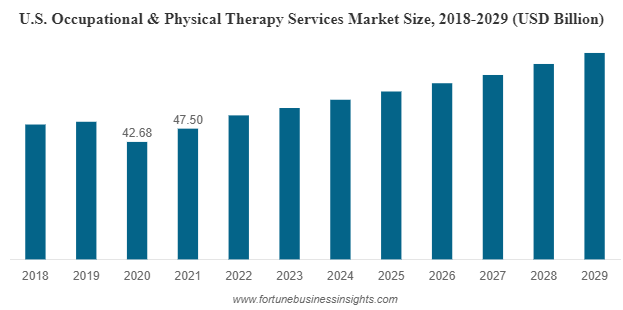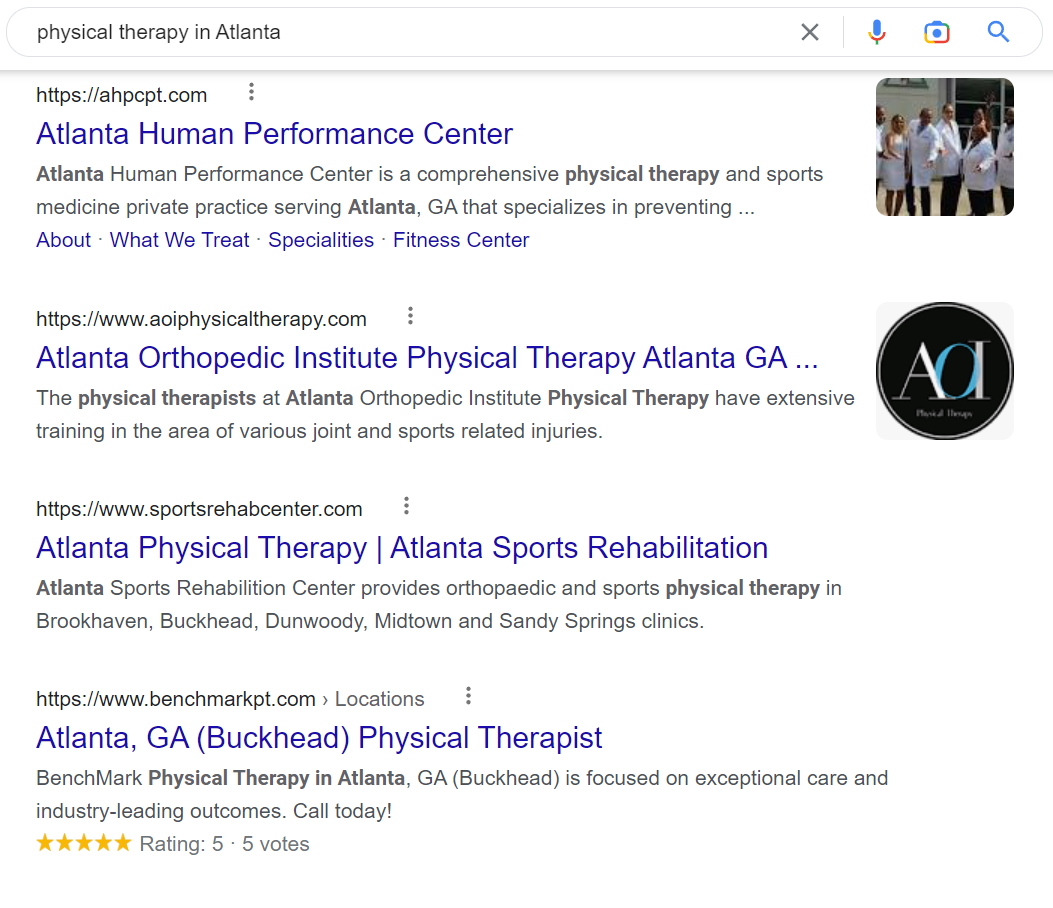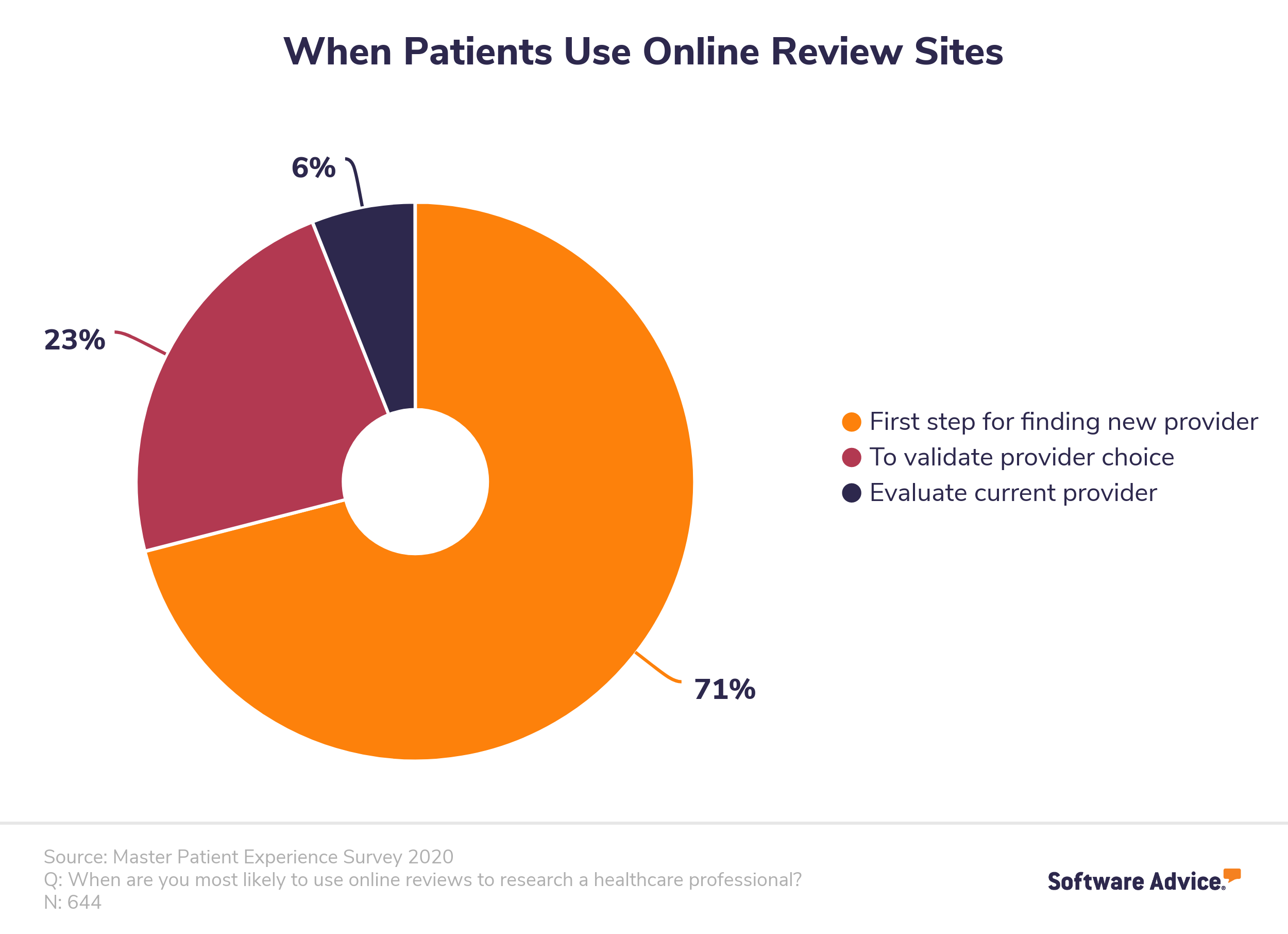Physical therapy was one of the most affected healthcare sectors during the COVID-19 pandemic. Service disruptions, reduction in patient visits, and workforce shortages are just the tip of the iceberg regarding the challenges PTs have faced during the pandemic. However, as we move to the post-pandemic era, the physical therapy market is expected to bounce back and experience significant growth.
According to market research, the occupational and physical therapy industry is projected to grow from $50.26 billion in 2022 to $72.70 billion by 2029, a CAGR of 5.4% during the broadcast period. The country has witnessed a steep increase in demand for PT solutions as they’re critical for improving the quality of life of individuals suffering from chronic pain, injuries, and cognitive disabilities. In addition, favorable reimbursement policies and increasing awareness about the benefits of therapy services are also major growth drivers.

As a result, the OT and PT arenas are also expected to become more competitive. Therefore, OT and PT providers should ensure their digital marketing strategy is on-point and involves high-level strategies like SEO, Google Ads, Facebook Ads, conversion rate optimization (CRO), web design, and reputation management.
Below are several practices that will help take your digital marketing strategy to new heights, increase your patient base, and gain that much-needed competitive edge.
Build a User-Friendly PT Website
Any digital marketing strategy starts with a website. Your physical therapy website is your digital front door and will likely be the first touchpoint for many of your patients. If your website cannot provide a user-friendly and comfortable digital experience, you will lose prospective patients that will choose your competitors instead. Thus, ensure your OT or PT website offers first-rate digital experiences to engage visitors and guide them to your conversion funnels.
Optimize for Speed, User Interface, and Mobile
A slow, poorly-designed website is a silent assassin of conversion rates. With that said, revisit your basics on web design, and make sure you can provide a comfortable, intuitive user experience with easy-to-read fonts, sensible layouts and menus, professional images, and clear call-to-actions (CTAs).
Moreover, your website should have fast loading speeds because 70% of consumers admitted that the speed of a website impacts their willingness to engage with the brand. Page speed is also a major ranking factor due to Google’s mobile-first indexing. Use tools like PageSpeed Insights to evaluate your website’s loading speeds and make optimal changes if needed.
Finally, your website should be mobile-friendly and has a responsive design. This is a must since half of the global website traffic comes from mobile devices, and most people browse your website on mobile. Responsive design ensures your website adapts to the screen it’s being viewed on, whether it’s on a desktop computer, laptop, tablet, or smartphone,
Implement Discoverability to Your Key Content
If you’re still worried about keyword density and word count, it’s time to revisit your content strategy. Google’s Helpful Content Update has completely changed the nature of content strategy. Now, you need to provide high-quality content that actually provides value to readers, not just optimized for search engines.
With that said, it’s not enough to publish top-notch healthcare content; you have to ensure they’re actually searchable and discoverable. Ensure your high-quality articles, blog posts, and service pages are correctly loaded on your site via your content management system (CMS). Don’t bury your content in hard-to-reach places, tons of linking, and poorly-designed menus.
Aligning Marketing with Operations for PT Practices
Running a physical therapy practice has its share of challenges, especially when aligning marketing and operations. But when these teams work together effectively, your marketing efforts improve, and day-to-day operations run more smoothly. It’s all about getting everyone on the same page to help your practice thrive.
Here’s how you can achieve total alignment with PT marketing and operations:
Service Line Alignment
Physical therapy practices often offer a variety of services, from sports injury rehabilitation to post-surgical recovery. Aligning your marketing efforts with specific service lines can help optimize your budget and attract the right patients.
Work with your operations team to identify the following:
- Most profitable services
- Services with the highest patient lifetime value
- Services that lead to additional treatments or referrals (upsell potential)
For instance, if your practice specializes in sports injury rehabilitation and this service has a high patient lifetime value, you might allocate more of your marketing budget to targeting athletes and sports enthusiasts. It comes down to attracting patients likely to benefit most from your services and provide long-term value to your practice.
Capacity Alignment
One crucial aspect of marketing-operations alignment for physical therapy practices is capacity management. Your marketing team should constantly communicate with operations to understand which locations or therapists are available and which are fully booked.
For example, suppose your downtown clinic is consistently booked for the next three weeks, but your suburban location has immediate openings. In that case, your marketing efforts should focus on driving patients to the location with available capacity. This can lead to optimized ad spend and timely patient care.
To achieve this, consider implementing a regular reporting system in which various branches share capacity data with marketing. This information can adjust ad spending and targeting in real time.
Messaging Alignment
Consistent messaging across all touchpoints is vital for building trust with potential patients. Your marketing team should work closely with operations to ensure that the promises made in advertisements align with the actual patient experience.
Think about it this way: if your marketing team is telling potential patients they can get in for an appointment quickly, your front desk and therapists need to be ready to make that happen. When what you promise matches what patients actually experience, everyone’s happy. But if there’s a mismatch, you might end up with some frustrated folks and not-so-great reviews.
Why not get your marketing folks and clinic team together to brainstorm and review your marketing messages? This way, you’ll ensure that your brand messaging matches up with what’s really happening in your practice.
Technology Alignment
Integrating Marketing Technology with Practice Management Systems
Consider integrating marketing technology with your practice management systems to improve your PT marketing efforts. This integration can provide valuable data for targeting and personalizing your marketing efforts.
For instance, you might implement a customer relationship management (CRM) system that integrates with your electronic health records (EHR) system. This integration can help you:
- Identify patterns in patient demographics and conditions
- Track patient engagement with your marketing materials
- Personalize follow-up communications based on treatment history
When implementing new technology, involve your marketing and operations teams in decision-making. This collaboration ensures that the chosen technology meets the needs of both departments and can be effectively integrated into existing workflows.
Utilizing Call Tracking for Quality Improvement
Implementing call-tracking technology can provide valuable insights for both marketing and operations. For PT practices, this technology can help:
- Evaluate the effectiveness of different marketing channels in driving phone inquiries
- Identify common patient questions and concerns
- Assess the quality of phone interactions with potential patients
Let’s say you start listening to some of your phone calls. You might notice that a lot of people are asking about insurance. That’s valuable info! You could use it to make your website more transparent about what insurance you take or help your front desk team get better at answering those questions.
Just remember: When you start using call tracking, make sure your team is on the same page. Explain how it helps your marketing and your patients’ experience.
Optimize Your Local Presence
Like many healthcare practices, occupational and physical therapy are predominantly local services. Therapists rely on attracting patients in their geographic area, while patients look for nearby rehabilitation centers and outpatient clinics for time and convenience. Outlined below are several best practices to help optimize your brand’s local presence:
Citations & Listings
One of the easiest ways to supercharge your local SEO is to claim local citations and listings. These are structured directories where you can supply complete and accurate information about your PT practice. Look for relevant local and national directories and claim them, including Yelp, Yellow Pages, Vitals, RateMDs, Healthgrades, and ZocDoc. Local citations and listings help search engines validate and add more credibility to your practice.
Claim and Optimize Google Business Profile
Google Business Profile or GBP (formerly Google My Business) is another critical tool for improving local SEO. Google is easily the most popular website, and most people use the search engine for information about local businesses. With an optimized GBP, you’ll have a stronger local presence and are 70% more likely to receive in-store visits than practices that don’t have the profile.
Optimize your GBP listing by providing the following information:
- Name of practice
- Address
- Website URL
- Contact information (phone number, email)
- Working hours
- Clinic and staff photos
- A short description of your rehab center
You can further optimize your profile by adding more content like photos, videos, and frequently asked questions (FAQs). FAQs are particularly significant since you’re supplying answers to the patients’ most common inquiries, removing several barriers to conversion.
Create Location-Optimized Web Pages
For multi-location occupational and physical therapy brands, one of the best practices is creating dedicated landing pages for each location. Make sure you’re using location-specific keywords to optimize your landing pages. These location-optimized landing pages will help increase your chances of ranking for location-based searches. Plus, these pages will also help you provide personalized user experiences, which many visitors appreciate.
Offering personalized experiences will allow users to feel like unique individuals with specific medical needs and circumstances. This is crucial because 76% of users expect personalized experiences when browsing.
Develop a Local Keyword Strategy
Obviously, you have to optimize keywords based on the areas you operate. Best practice dictates that you should build a local keyword list based on your unique selling proposition or USP (i.e., specialties or unique service lines), target local area, and how patients search for your PT or OT services. Below are the two main types of local SEO keywords:
- High-intent, solution-aware keywords: This user knows that they need the services of an occupational or physical therapist.
- Location-based keywords: These long-tail keywords and phrases have geographical identifiers, such as “physical therapy in atlanta” or “sports physical therapy boston.”

When developing your local SEO keyword list, be more specific and granular by honing in on your USPs, so you’ll have less competition and more patients coming in.
Attract High-Quality Patients With Google Ads
Google Ads or PPC marketing is one of the most important strategies for healthcare marketers to grow their practice. Paid search allows you to capture patients as they’re about to make a decision (i.e., people already looking for a therapist). For instance, if a searcher uses a high-intent keyword like “kinesiology taping near me,” they know the problem and the potential solution. With an optimized PPC campaign, your ads will show up at the top of the Google SERPs, essentially putting your rehab center or outpatient clinic in front of someone actively looking for a therapist.
Below are some best practices for optimizing your Google Ads campaign:
Choosing an Account Structure
PPC has evolved and is now leaning towards automation. Although automation has made the lives of marketers simple, it’s hard not to feel the loss of autonomy. To regain that sense of control and not just leave your account on auto-pilot (definitely not recommended), you should revisit your PPC account structure to get the most out of Google Ads.
Having said that, we always recommend that our multi-group clients use hybrid accounts. While it’s not a perfect structure, hybrid allows multi-location healthcare groups to benefit from the best qualities of segmented and consolidated accounts. This means you’re maximizing ad impressions from consolidated accounts and having better budget control and tighter targeting metrics with segmented account structures.
Once you’ve decided on your account structure, optimizing your campaign to leverage Google’s smart bidding algorithm is next. At this point, feel free to experiment with bidding strategies for optimal results.
Aligning Paid Ads with Search Intent
Successful PPC marketers know the importance of aligning PPC ads with search intent along the buyer’s funnel. This encourages keyword diversity to cover the entirety of the funnel, including:
- Lower funnel “product aware” leads: These people are on the cusp of conversion and know they need a therapist. Use high-intent, product-aware keywords to capture these prospective patients.
- Mid-funnel “solution aware” leads: These people may have mobility issues or injuries but are unsure which medical treatments to get. Use educational keywords designed to highlight OT and PT treatments and services such as aerobic activities, gait training, rehabilitative therapies, etc.
- Upper funnel “problem aware” leads: These people know there’s a problem and are actively looking for the solution. At this stage, optimize for lower-intent keywords like “what does a physical therapist do.”
Leverage Your Online Reputation
Consumer behavior has significantly changed over the last decade. Gone are the days when healthcare practitioners rely on referrals and word of mouth to get patients. Nowadays, 90% of prospective patients will read online reviews when searching for healthcare providers. If your practice mainly has negative or too few reviews, most patients will likely skip you in favor of your competitors. Conversely, a positive online reputation will help you attract more patients and referrals, provided you can leverage it.

Reputation Management Best Practices
Directly asking patients for reviews is your best strategy to enhance your online reputation. Train your front-facing staff members to collect, manage, and respond to online reviews of your practice. Most patients will not voluntarily leave reviews on their own, but most will happily oblige if you simply ask them, especially following a good experience.
In addition, provide numerous ways for patients to leave feedback, but ensure all of them are quick and easy to complete. Some suitable methods include short patient surveys, SMS requests, and follow-up emails. If they’re ever so inclined, ask patients to leave reviews on your Google profile and social media accounts because you can showcase them for the best results.
Alternatively, you may invest in review solicitation programs like Birdeye, Podium, and Weave. These programs will streamline your review management process and can seamlessly integrate with your CRMs. Finally, ensure you showcase positive patient reviews on your website (About Us and dedicated review pages), landing pages, and social media accounts.
Use Video Marketing for Therapists
Like many digital solutions, the healthcare industry is slow to adopt video marketing, including physical therapy. Many therapists simply don’t consider video marketing to be a viable strategy to market themselves–don’t make the same mistake. Video marketing is beneficial for growing your practice and expanding your patient base.
As demonstrated by platforms like YouTube and TikTok, video content is more engaging, and leveraging videos will instantly give you an edge over your competitors. Plus, video marketing gives a face to your rehab or clinic, humanizes it, and establishes your PT/OT brand before prospective patients.
For physical therapists, you can produce demonstration videos of stretches and exercises that patients can perform in their homes or your clinic or a quick Q&A about your services. In addition, you can also create clinic tour videos where you can showcase your facility and company culture. Lastly, see if you can onboard current and previous patients to produce a video about reviews and testimonials.
Conclusion
Physical therapy practices will remain in high demand, but there will always be a great deal of competition. Not only are you competing with major hospitals and private equity organizations, but you’ll also be competing with private practices. Fully-realized digital marketing for physical therapists will not only help enhance patient acquisition but also help your practice stay competitive.

